SUNGKYUNKWAN UNIVERSITY (SKKU), SEOUL, KOREA
- Professor Chun Gwon Park Develops Immunotherapy Technology That Can Prevent
Cancer Recurrence - Research on Fabrication of Biomimetic Microfibril Structures Using 3D Printing
- Professor Yong Taik Lim Develops Implantation of Synthetic Immune Niche that Prevents
Tumor Recurrence - Professor Won-Sub Yoon Develops High-Performance Battery That Can Travel up to 400km
with One Charge - Fabrication of a Stable New Polymorph Gold Nanowire with Sixfold Rotational Symmetry
- Perovskite Solar Cells with Inorganic Electron & Hole Transport Layers Exhibit
Long-Term Stability - A Peak in the Critical Current for Quantum Critical Superconductors
- Simultaneous Control of Multiple Ferromagnetic Materials Ferroelectricity and Ferromagnetism
- Identification of Epigenetic Gene Regulation in the Genome of Marine Seaweed by
Prof. Hwansu Yoon - Direct Imaging of Two Dimensional Electron Gas by Electron Holography

The duo of Prof. Chun Gwon Park (Department of Biomedical Engineering at (Sungkyunkwan University) and Prof. Michael Goldberg developed (Harvard Medical School and Dana-Farber Cancer Institute) developed a localized cancer immunotherapy that prevents tumor recurrence and metastasis after surgical removal in mice. Their findings show that applying cancer immunotherapy in conjunction with surgery could help prevent tumor metastasis, which accounts for 90% of cancer-related deaths.
Surgery is the most common treatment for cancer, but the resulting healing process places stress on the body and suppresses the immune system, leading to an increased likelihood of metastasis and tumor recurrence. Previous research has explored the possibility of using cancer immunotherapy to counter the drawbacks of surgery, but response rates are often poor and need improvement.
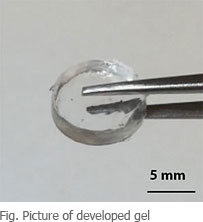 To address the shortcomings of both methods, Prof. Park and his colleagues created biodegradable gel discs that slowly release different types of innate immune system agonists, or molecules that trigger a response from the innate immune system. The team then implanted the discs into the surgical sites of mice with breast cancer, lung cancer or melanoma after removing their tumors and monitored the mice over the next 12 weeks. They found that mice which were implanted with gels containing agonists did not experience tumor recurrence or secondary tumors in other regions of their body, and had higher survival rates than mice that did not receive the gel discs. More importantly, the study also showed that delivering the compounds via the gel was safe and more effective in preventing tumor recurrence than intravenous administration or local injections.
To address the shortcomings of both methods, Prof. Park and his colleagues created biodegradable gel discs that slowly release different types of innate immune system agonists, or molecules that trigger a response from the innate immune system. The team then implanted the discs into the surgical sites of mice with breast cancer, lung cancer or melanoma after removing their tumors and monitored the mice over the next 12 weeks. They found that mice which were implanted with gels containing agonists did not experience tumor recurrence or secondary tumors in other regions of their body, and had higher survival rates than mice that did not receive the gel discs. More importantly, the study also showed that delivering the compounds via the gel was safe and more effective in preventing tumor recurrence than intravenous administration or local injections.
"This approach has the potential to deliver immunotherapy in a manner that focuses the therapy at the site of interest within a critical time window. We are extremely encouraged by the results of this study and are hopeful that this technology will be adapted for patients and testing in clinical trials in the near future," said Prof. Park and Prof. Goldberg.
Published article: C. G. Park, C. A. Hartl, D. Schmid, E. M. Carmona, H.-J. Kim, M. S. Goldberg, Extended release of perioperative immunotherapy prevents tumor recurrence and eliminates metastases. Sci. Transl. Med. 10, eaar1916 (2018).
Article link: http://stm.sciencemag.org/content/10/433/eaar1916

In the human body, microfibril structures can be found in several types of tissue, such as muscles, nerves, and even tendons. In particular, muscle tissues have uniaxially-aligned microfibrous structures.
The team (first author: Won Jin Kim) led by Geun Hyung Kim (Department of Biomechatronics Engineering at Sungkyunkwan University) fabricated a structure composed of bundled poly (e-caprolactone) (PCL) microfibers coated with collagen. To obtain the bundle of uniaxially-aligned (PCL) microfibers, 4D printing methods using a poly (vinyl alcohol) (PVA) fibrillation/leaching process were used. PVA was dissolved in distilled water to fibrillate the PVA. Then, PCL was added to the PVA solution and mixed. After mixing, the PVA/PCL mixture was printed using a 3D printer. The fabricated 3D structure was immersed in water to leach the fibrillated PVA.
By using this simple fabricating method, a uniaxially micropatterned/fibrous PCL bundle was achieved. The fabricated structure was supplemented with collagen to increase the biocompatibility of the PCL bundle. The hybrid microfibrillated structure promoted myoblast proliferation and myogenic differentiation.
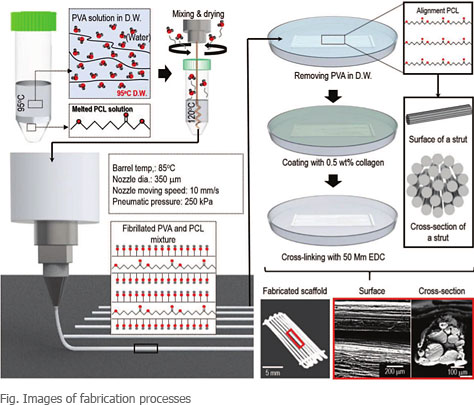
"Due to the 4D printing process, it was able to have high efficiency in the fabrication of 3D scaffolds with highly aligned microfibrous bundles. In addition, a variety of designs and complex microscale-patterned 3D structures were constructed because of a highly versatile 3D printing method," Prof. Geun Hyung Kim explained.
Published article: W. Kim, M. Kim, G. H. Kim, Adv. Funct. Mater. 2018, 1800405.
Article link: https://onlinelibrary.wiley.com/doi/epdf/10.1002/adfm.201800405

Prof. Yong Taik Lim developed implantation of synthetic immune niche that prevents tumor recurrence.
Cancer vaccines are an attractive option for improving disease-free survival following surgical resection of solid tumors. However, several clinical studies have shown that while cancer vaccines can routinely induce protection in a prophylactic model, the same vaccines often show only limited therapeutic efficacy.
The tumor immunosuppressive network, formed by interactions between cancer cells and host immune cells, is a major obstacle to achieving complete tumor eradication. Myeloid-derived suppressor cells (MDSCs) can be considered critical players in tumor-induced immunosuppression in both animal models and cancer patients because they have a remarkable ability to suppress the activation and proliferation of T cells. Therefore, the depletion of MDSCs can strengthen the immunity of tumor-bearing mice.
Recently, Prof. Yong Taik Lim's group at Sungkyunkwan University reported a novel implantable, engineered 3-dimensional porous scaffolds which were designed to generate synergistic action between MDSC-depleting agents and cancer vaccines consisting of whole tumor lysates and nanogel-based adjuvants. The local peritumoral implantation of the synthetic immune niche (termed immuneCare-DISC, iCD) as a post-surgical treatment in an advanced-stage primary 4T1 breast tumor model generated systemic anti-tumor immunity and prevented tumor recurrence at the surgical site as well as the migration of residual tumor cells into the lungs, resulting in 100% survival.
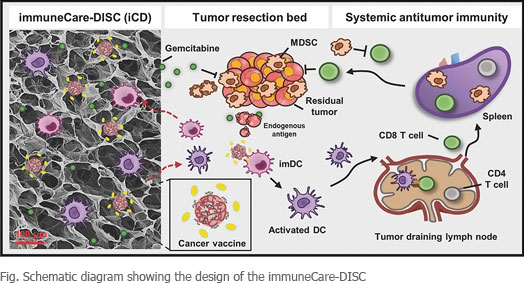
These therapeutic outcomes were achieved through the inhibition of immunosuppressive MDSCs in tumors and spleens by releasing gemcitabine and recruitment/activation of dendritic cells, enhanced population of CD4+ and CD8+ T cells, and increased IFN-γ production by cancer vaccines from the iCD. This combined spatiotemporal modulation of tumor-derived immunosuppression and vaccine-induced immune stimulation through the iCD is expected to provide an immune niche for preventing of postoperative tumor recurrence and metastasis.
The results of the study were published in the international science journal, "Advanced Materials" on March 23rd.
Find more information at: https://onlinelibrary.wiley.com/doi/10.1002/adma.201706719

A research team led by Prof. Won-Sub Yoon, Department of Energy Science, discovered the possibility of developing a high-performance battery that can travel up to 400km by one charge.
While the technology of lithium ion batteries has been very successful since its advent in powering portable electronic devices, further advancements are insatiably demanding for wider applications such as in electric vehicles and grid-power storages. One of the key aspects of these efforts is development of new positive electrode "cathode" materials with higher energy densities to replace the lithium cobalt oxide that is currently prevailing as the cathode material.
The research is very focused on increasing the amount of Li-ions "inserted" in the electrode material, which affects the charge storage capacity, the speed of Li-ion movement within the crystal lattice of the electrode material, which affects the battery power, and the structural stability of the material upon in-and-out transport of Li-ion, which affects the battery life. Compared to other material families, the "layered" materials are the most attractive with regard to the three attributes listed above, and layered lithium transition metal oxides containing nickel (Ni), cobalt (Co), and manganese (Mn) have recently emerged as a promising family of cathode materials.
Aside from lithium ions, other elements play a role as building blocks forming a host structure for Li-ions (guests) to be inserted or extracted. Depending on the properties of the host structure, its electrochemical performance as a battery material is determined. For these multicomponent layered systems, the current trend moves toward increasing the content of Ni in layered systems (known as Ni-rich layered materials) since Ni is capable of delivering double the charge, i.e., Li-ions of the other two. As Ni atoms occupy a large part of the transition metal layer in the host structure, it becomes a major factor in determining the overall properties of the host structure. Therefore, understanding the effect of increasing Ni content on the layered structure is important to designing high-energy electrode materials.
This series of materials containing Ni and other elements appear to inevitably have so-called "cation disorder", a phenomenon in which some of the Li-ions and Ni atoms switch positions from their own layers. This happens due to the fact that some of the Ni atoms exist in the valence state 2+ lower than Co or Mn as synthesized. The presence of Ni atoms in the Li-ion layer adversely affects the Li-ion movement in the Li-ion layer. In contrast to such a general perception, the study finds that the degree of cation disorders is mitigated upon increasing the Ni content in the lattice up to a certain concentration, and also reports that the oxidation state of Ni in the pristine compounds contributes significantly to cation disorder. Moreover, it is demonstrated that the extent of cation disorder critically affects the phase transition behavior during charging or discharging, and as a result, the phase transition becomes smoother with increasing Ni content. This smooth phase transition reduces the strain on structural behavior during cycling; consequently, it enhances the cycle performance of the electrode material.
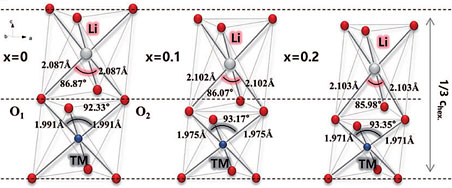
In addition to the relationship between the Ni content and the phase transition, it was discovered that the actual environment in which Li-ions are situated is not directly linked to the total height, a sum of the Li-ion layer and the transition metal layer (c-axis). The height of the lithium layer becomes larger with increasing Ni content, even though the c-axis decreases. More importantly, it is shown that the lithium ion channel retains the environment where lithium ions can visit or leave, even if the c-axis shrinks from the initial dimension.
The results for the Ni-rich layered materials that are counter-intuitive account for the superior electrochemical performance, and address the misconception of Ni element in Ni-rich layered systems. Furthermore, this article provides a new perspective on the role of Ni in layered systems and disputes the conventional view concerning the c-axis parameter that has been considered a key factor in interpreting the behavior of Li-ion movement and the corresponding electrochemical performance. Hence, these results may suggest some aspects to consider in the design of high-energy electrode materials for next-generation batteries. This study was selected as a cover paper of "Advanced Energy Materials".
Find more information at: https://onlinelibrary.wiley.com/doi/abs/10.1002/aenm.201701788

Prof. Hyunjung Shin, Department of Energy Science, discovered a new stable structure of gold with different physical properties.
Gold is the first metal used by humans, and it is deeply involved in human life. This was possible because gold was found to be almost pure in nature and easy to process without heating or melting. As one of the most chemically stable metals, gold adopts only one crystal structure.
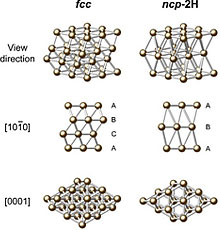 The crystal structure is closely related to the intrinsic properties of materials. When the crystal structure is changed, physical and chemical properties, including electrical and optical properties, are changed. Therefore, it is important to control the polymorphism to achieve reliable material or device properties.
The crystal structure is closely related to the intrinsic properties of materials. When the crystal structure is changed, physical and chemical properties, including electrical and optical properties, are changed. Therefore, it is important to control the polymorphism to achieve reliable material or device properties.
The crystal structure of gold is face-centered cubic (fcc) with 3-fold rotational symmetry by nature. For the first time, Prof. Shin, Ms. Lee, and Dr. Bae (Department of Energy Science at Sungkyunkwan University) had their research on a stable hexagonal non-close packed structure (ncp-2H) of gold published in Advanced Materials (IF 19.791) as a cover story. They reported not only excellent stability of ncp-2H gold, but also different physical properties different from those of fcc.

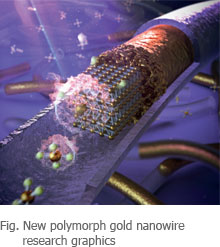 The research team fabricated the gold nanowires in a confined system of TiO2 nanotubes via the photoelectrochemical reduction of gold ions. During ultraviolet illumination, excited photoelectrons in the conduction band of TiO2 reduced the Au ions to metallic Au. At the early stage of the nucleation process, various polymorphs are able to be formed. However, they are eventually transformed to fcc, the most thermodynamically stable form in nature. The research team suggested that isolated ncp-2H gold seeds at the nucleation stage survive and grow by a diffusion-limited process under the nanoscale confinement provided by TiO2 nanotubes. They supported the possibility that nanoscale confinement influenced polymorph formation through control experiments.
The research team fabricated the gold nanowires in a confined system of TiO2 nanotubes via the photoelectrochemical reduction of gold ions. During ultraviolet illumination, excited photoelectrons in the conduction band of TiO2 reduced the Au ions to metallic Au. At the early stage of the nucleation process, various polymorphs are able to be formed. However, they are eventually transformed to fcc, the most thermodynamically stable form in nature. The research team suggested that isolated ncp-2H gold seeds at the nucleation stage survive and grow by a diffusion-limited process under the nanoscale confinement provided by TiO2 nanotubes. They supported the possibility that nanoscale confinement influenced polymorph formation through control experiments.
This study is particularly noteworthy because it suggests that different theories from classical thermodynamics are required for nanoscale confined systems.
Published article: S. Lee, C. Bae, J. Lee, S. Lee, S. H. Oh, J. Kim, G.-S. Park, H. S. Jung and H. Shin, "Fabrication of a Stable New Polymorph Gold Nanowire with Sixfold Rotational Symmetry", Advanced Materials, 30, 1706261 (2018). (Cover Illustration)
Find more information at: https://onlinelibrary.wiley.com/doi/pdf/10.1002/adma.201706261

Prof. Hyunjung Shin and Prof. Nam-Gyu Park have jointly announced that they have succeeded in developing technologies to dramatically improve the stability of the perovskite solar cell, which is widely regarded as the next generation solar cell material.
Perovskite is the name of a crystal structure and refers to a group of materials of special composition using the organic-inorganic halide elements as the latest generation solar cells. Perovskite solar cells are a high efficiency visible light absorbing layer with a light conversion efficiency exceeding 22% for a short period of research and are of great interest to many researchers worldwide.
Last year, Professor Nam-Gyu Park was nominated winner of the Nobel Prize in Chemistry for his pioneering work in solar cell research. This material has very good photoelectric properties and at the same time it has the advantage of being low in cost, but it is pointed out as a hindrance to industrialization because of its short life span due to moisture, heat, and light.
The architecture of the solar cells has inverted planar devices (so-called p-i-n devices; light illumination through hole transport layers) with FTO/NiO/Perovskite/PCBM/AZO/Ag. AZO has been deposited via atomic layer deposition method, which produces pinhole-free, uniform, and dense films. The AZO-deposited perovskite solar cells exhibited similar performances to the control solar cells due to negligible charge transporting retardation by the 3 orders of magnitude higher conductivity of AZO compared to that of PCBM. The ALD-grown AZO (ALD-AZO) layers also acted as dense, uniform, and impermeable passivation layers that prevented ingress of water into the perovskite films, egress of the volatile components of perovskite when heated, and interfacial degradation between the perovskite-PCBM heterojunction and the Ag electrode caused by unfavorable chemical reactions.
The authors found that the stability of perovskite solar cells with an AZO layer is superior to the control devices. While the control solar cells degraded rapidly under light illumination at room temperature in spite of an additional passivation layer, AZO-perovskite solar cells maintained 99.5% of their initial efficiency for 500 hours. The unique role of AZO, distinguished from additional passivating layers, is to prevent moisture penetration as well as interdiffusion at the perovskite/Ag interface when illuminated. These perovskite solar cells showed their stability in a more severe environment, exhibiting a power conversion efficiency of 18.45% and retaining 86.7% of their initial efficiency for 500 hours under continuous 1-sun illumination at 85°C in ambient air with electrical biases (at the maximum power point).
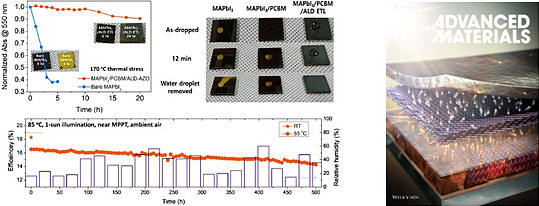
This research on highly stable perovskite solar cells with inorganic charge transport layers has been published in "Advanced Materials (IF 19.791) as an inside cover story by Prof. Shin and Mr. Seo (Department of Energy Science) and Prof. Park (School of Chemical Engineering) at Sungkyunkwan University.
Published article: Seo, S., Jeong, S., Bae, C., Park, N.-G., and Shin, H., "Perovskite Solar Cells with Inorganic Electron- and Hole-Transport Layers Exhibiting Long-Term (≈500 h) Stability at 85°C under Continuous 1 Sun Illumination in Ambient Air.", Advanced Materials, 1801010 (2018).
Find more information at: https://onlinelibrary.wiley.com/doi/pdf/10.1002/adma.201801010

Professor Tuson Park and Research Professor Soongil Jung in the Department of Physics clarified the principle of formation of unsteady superconductors, one of the unsolved problems in solid physics.
Generally, studies of the critical current Ics, which set the current limit below which there is a zero-resistance state, is necessary if superconductors are to be of practical use. In their study, the research team reported a peak in the pressure dependence of the zero-field Ic, Ic(0), at a hidden quantum critical point (QCP), where a continuous antiferromagnetic transition temperature is suppressed by pressure toward 0 K in CeRhIn5 and 4.4% Sn-doped CeRhIn5.
They explained, "The Ic(0)s of these Ce-based compounds under pressure exhibit a universal temperature dependence, underlining that the peak in zero-field Ic(P) is determined predominantly by critical fluctuations associated with the hidden QCP. The dc conductivity σdc is a minimum at the QCP, showing anti-correlation with Ic(0)."
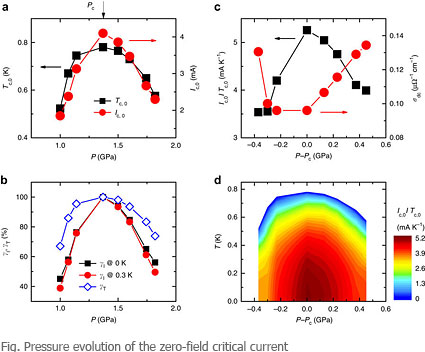
These discoveries demonstrate that a quantum critical point hidden inside the superconducting phase in strongly correlated materials can be exposed by the zero-field Ic, therefore providing a direct link between a QCP and unconventional superconductivity.
The results of this research have been published in the worldwide scientific journal "Nature" on January 30th.
Find more information at: http://www.nature.com/articles/s41467-018-02899-5

A research team led by Prof. Youngmin Kim together with the Gwangju Institute of Science and Technology identified the principles of ferroelectricity and ferromagnetism at the same time.
Ferroelectric materials that form an electric field are used in computer memory chips, capacitors, and the like. In the case of magnetic ferromagnetic materials, they are mainly used for hard disk magnetic heads and electric appliances motors.
It is not easy to control both properties at the same time. The team has artificially controlled the oxygen atom position of the bismuth cetylsulphide film, which is a multi-stiff material, and has exceeded its limit. "By developing high-quality thin film manufacturing technology, we have increased the thickness of thin film that can control oxygen atom position by more than 10 times. As a result, the ferroelectricity and ferromagnetic properties have improved by more than two times compared to conventional devices," the researchers explained. "Until now, it was possible to control the position of oxygen atoms only in the interface area of less than a few nanometers. It was difficult to measure ferroelectricity and ferromagneticity," they also added.
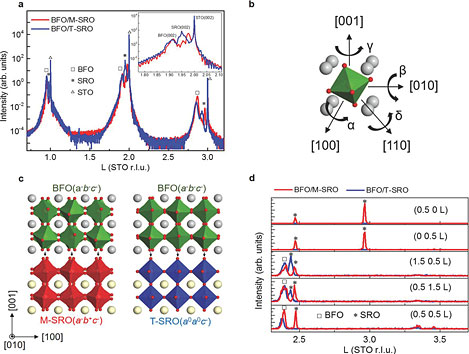
The research was supported by Taeyoung Choi of Pohang Accelerator Research Institute, Prof. Yoonseok Kim, Prof. Byungki Jo of Gwangju Institute of Science and Technology, and Prof. Junhee Lee of Ulsan Institute of Science and Technology. The paper on the achievements was published on the cover of "Advanced Functional Materials" on March 26th.
Find more information at: https://onlinelibrary.wiley.com/doi/10.1002/adfm.201800839

After completing the first human draft genome by the Human Genome Project (HGP) in 2003, many genome projects were initiated in the field of medicine and natural science. A genome is the total set of genetic information including all the genes of a living organism; therefore, if it is completely decoded, it will provide a lot of information about the function of the genes as well as the evolutionary relationship of living organisms. Recently, "Collaborative Genome Projects" have been launched by multiple ministries, and the Ministry of Oceans and Fisheries aims to decode genomes from 100 marine organisms.
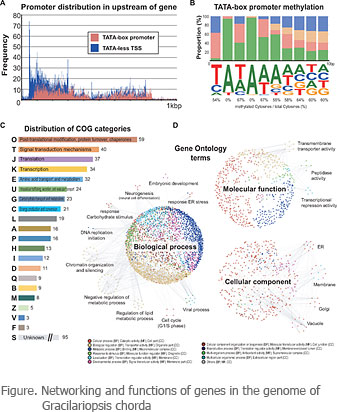
Professor Hwan Su Yoon and his research group in the Department of Biological Sciences are leading the analysis of 30 marine algal genomes, including diverse seaweeds. As the first product, they completed the whole genome of Gracilariopsis chorda and published in "Molecular Biology and Evolution" (5 years IF 14.558). It is the second complete nuclear genome among approximately 7,000 red algal seaweed species. G. chorda is a popular edible seaweed for diet foods and salads, and it is also used in the agar production industry.
From this paper, they generated a high-quality 92.1 Mb draft genome assembly from the red seaweed G. chorda, including methylation and small (s)RNA data. They analyzed these as well as other Archaeplastida genomes to address three questions: 1) What is the role of repeats and transposable elements (TEs) in the genome size variation of red algae, 2) what is the history of genome duplication and gene family expansion/reduction in these taxa, and 3) is there any evidence for TE suppression in the genome of red algae? See the details at the MBE journal website (https://doi.org/10.1093/molbev/msy081).
Furthermore, Prof. Yoon's group has utilized the genome information to the application field. For example, the carbonic anhydrase of G. chorda shows much higher activities than that of humans. The carbonic anhydrase catalyzes the rapid interconversion of carbon dioxide and water to bicarbonate and protons (or vice versa); therefore, it could be used to remove carbon dioxide from polluted gases (collaborative research with Prof. Inhwan Hwang at POSTECH). In addition, with Prof. Jong Hwan Kwak in the Department of Pharmacology, they found highly effective metabolic compounds for alleviating diabetes and arteriosclerosis from G. chorda. In this manner, the genomic information from marine algae is a valuable resource not only for academic, but also industrial purposes.
The result of the research was published in "Molecular Biology and Evolution" on April 23rd.
See Prof. YOON's other research activities at:
http://bio.skku.edu/glter/wiki/Hwan%20Su%20Yoon

A research team led by Prof. Sangho Oh of the Department of Energy Science observed a much smaller distribution of electrons by observing proteins, nanoparticles, and atoms.
Precise control of the amount of electrons to form at a desired position, and the technology to move it as quickly as possible is a key technology closely related to the performance of semiconductor memory devices and LED optical devices. In order to effectively control the electrons, a high-resolution microscopic observation method that can visually verify and analyze the distribution of the theoretically predicted electrons is needed.
The team developed a method to visually observe the two-dimensional electron gas formed between two kinds of oxides (LaAlO3 / SrTiO3) using "inline electron holography" which is very sensitive.
Two-dimensional electron gas refers to a conductive electron bunch formed at the interface of two materials. In the present study, the intrinsic properties of the two-dimensional electron gas were analyzed by correcting all the parameters precisely, although the signal was weak to observe by electron microscope and the influence of several variables was considered.
Through the developed method, it was observed that the distribution and the density of the two-dimensional electron gas change finely according to the crystal orientation (the angle and the direction in which the atoms are joined). This is a quantum phenomenon that occurs because the energy level of electrons changes according to the observation direction, the researchers explained.
Professor Sangho Oh said, "This study was the first to directly observe electron distribution and density changes caused by various quantum phenomena such as ferromagnetic, superconducting, and metal-insulator phase transition and it will play an important role in connecting quantum phenomena to device research."
This research was supported by the Ministry of Science and Technology, Ministry of Information and Communication, the Korea Research Foundation Future Material Discovery Project, Basic Research Project (Advanced Research), and the US Air Force Asia Office (AOARD). The result of this research was published in the March issue of "Nature Nanotechnology", an international journal in nanotechnology.
Find more information at: http://www.nature.com/articles/s41565-017-0040-8























